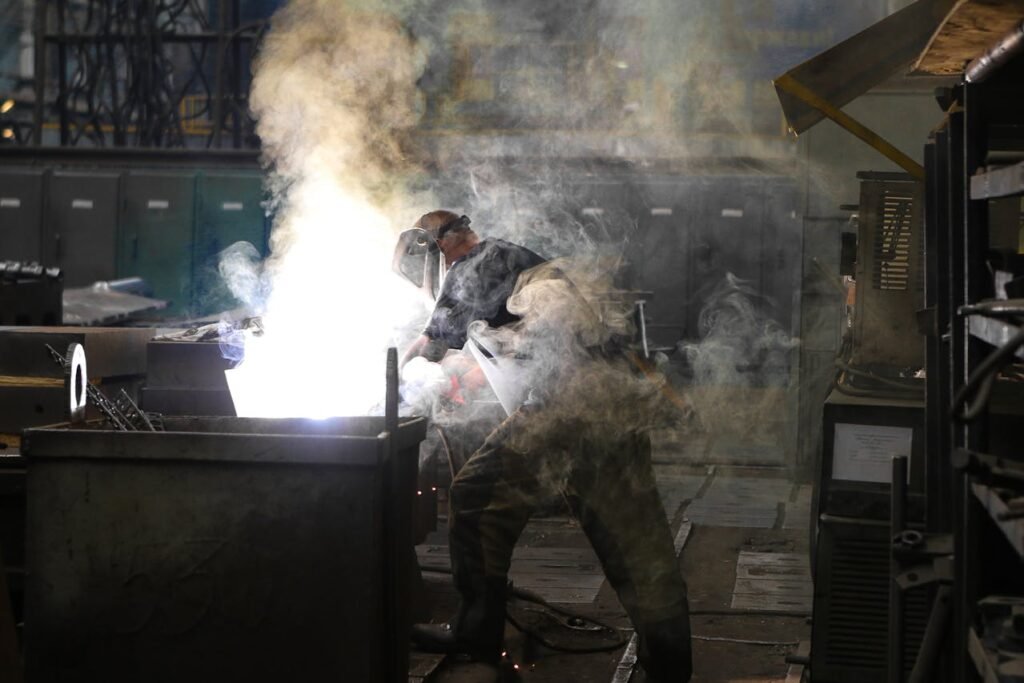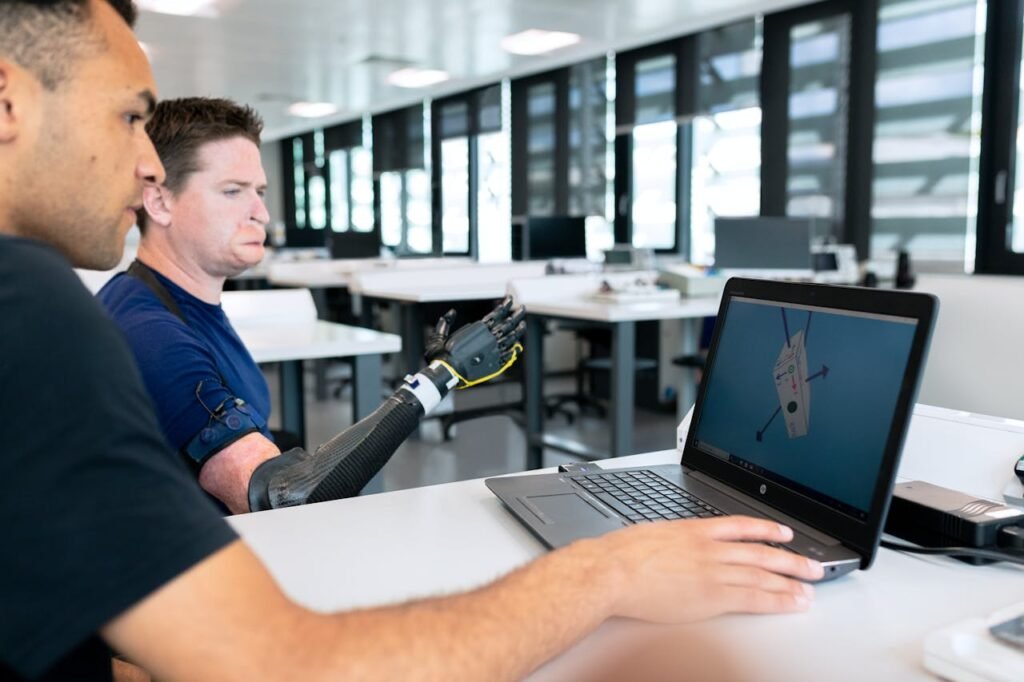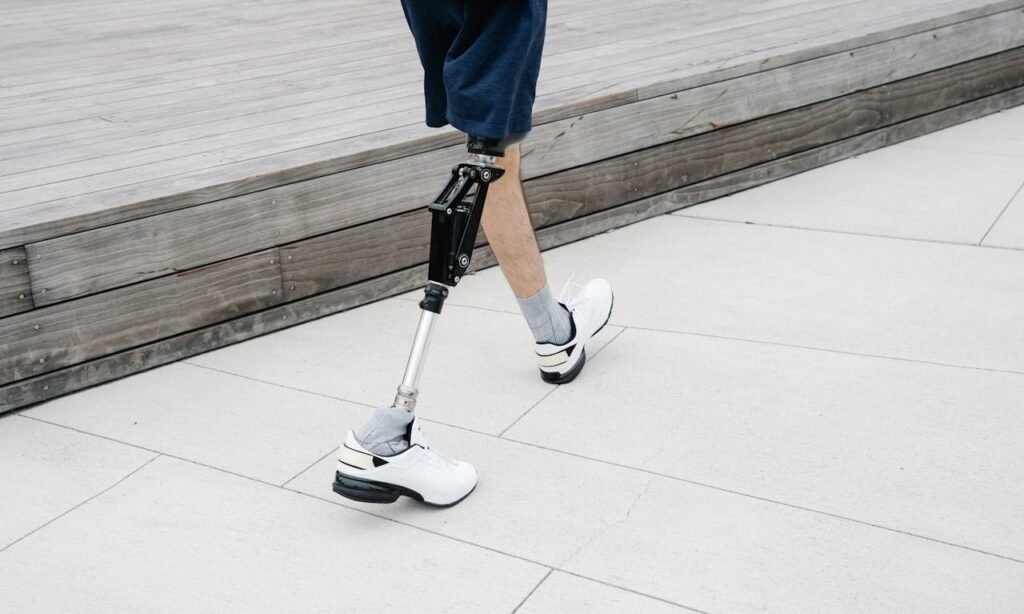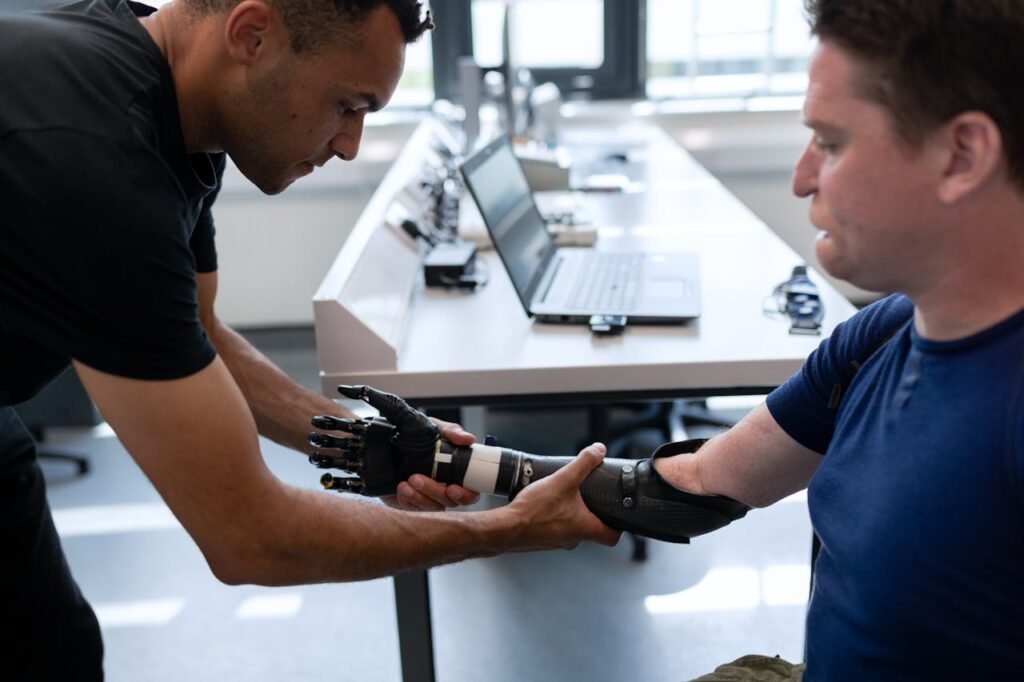Workplaces are changing. As companies strive to build environments that are more inclusive, one area of focus is creating opportunities for individuals with physical disabilities. Adaptive prosthetics are playing a transformative role in this shift, enabling people with limb loss to perform tasks that once seemed out of reach. With these advanced devices, employees can not only rejoin the workforce but thrive in roles that require skill, creativity, and collaboration.
At Robobionics, we understand the challenges faced by individuals with limb loss as they re-enter the professional world. Adaptive prosthetics are not just tools—they are enablers of independence, productivity, and self-confidence. This article explores how these innovations are reshaping workplaces, supporting inclusivity, and offering businesses actionable strategies to empower their workforce.
The Role of Adaptive Prosthetics in Modern Workplaces
Adaptive prosthetics are more than medical devices; they are sophisticated tools that integrate advanced technology with user needs. They enable individuals with limb loss to perform tasks with precision, efficiency, and comfort, effectively leveling the playing field in the workplace.
Enhancing Productivity and Efficiency
Workplace tasks often demand fine motor skills, strength, or prolonged physical activity. For someone with limb loss, these challenges can be daunting without the right support.
Adaptive prosthetics bridge the gap, offering features such as multi-grip modes, sensory feedback, and lightweight designs that make routine tasks manageable.
For instance, a prosthetic hand equipped with multi-grip functionality allows users to alternate between holding tools, typing on a keyboard, or carrying objects—all seamlessly. Employees using such devices are able to focus on their work rather than being limited by their physical abilities.

Building Confidence Through Independence
Adaptive prosthetics do more than restore physical ability—they empower individuals to regain their independence. For employees, this means being able to perform tasks without constant assistance or modifications to their workspace.
This independence fosters a sense of ownership over their work, boosting morale and confidence.
Imagine an architect using a prosthetic hand to sketch blueprints or a technician repairing machinery with precision tools. These are not just scenarios—they’re realities enabled by today’s advanced prosthetics.
Businesses that embrace these technologies send a powerful message: every employee has the potential to contribute meaningfully, regardless of physical challenges.
Breaking Barriers: Redefining Workplace Accessibility
Inclusive workplaces are about more than ramps and elevators—they’re about creating environments where all employees can thrive. Adaptive prosthetics play a critical role in achieving this vision by expanding what’s possible for individuals with limb loss.
Creating Equal Opportunities
Historically, certain roles have been considered inaccessible to people with physical disabilities. Adaptive prosthetics are changing this narrative by enabling individuals to meet the physical demands of various professions.
From surgeons performing intricate operations to engineers assembling complex components, these devices ensure that talent and skill take precedence over physical limitations.
Robobionics works closely with professionals to develop prosthetics tailored to their specific job requirements. By customizing solutions, we ensure that individuals can not only perform their duties but excel in their chosen fields.

Promoting Inclusivity in Workplace Culture
Inclusion is not just about physical accessibility—it’s about creating a culture where diversity is celebrated. When businesses invest in adaptive prosthetics for their employees, they demonstrate a commitment to inclusivity that goes beyond compliance.
This fosters a workplace environment where all employees feel valued and supported.
Leaders play a crucial role in shaping this culture. By openly embracing the use of prosthetics and showcasing the achievements of employees who use them, companies can inspire a ripple effect, encouraging peers to see ability, not limitations.
Incorporating Universal Design Principles
One of the most effective ways to redefine accessibility is by adopting universal design principles. These principles aim to create environments that are inherently usable by people with a wide range of abilities.
For businesses, this means designing spaces and processes that are inclusive from the outset, rather than retrofitting accessibility features later.
Universal design benefits everyone in the workplace, not just employees with disabilities. For example, touchless entry systems, wide hallways, and ergonomic furniture improve usability and comfort for all team members, while also fostering inclusivity.
Making Workplaces Prosthetic-Friendly
While adaptive prosthetics enable employees with limb loss to perform tasks effectively, the workplace environment itself must support their use. Simple but impactful changes can make a significant difference in helping employees feel comfortable and capable.
For instance, workstations should accommodate a range of physical needs, such as height-adjustable desks or flexible seating arrangements. Tools and equipment can be adapted to complement prosthetic use, such as by incorporating touch-free or voice-activated systems.
By ensuring that the workplace is designed with prosthetics in mind, businesses create a space where employees can fully integrate their capabilities without unnecessary barriers.
Optimizing Workstations for Prosthetic Use
Workstations are the cornerstone of productivity, and they must cater to the unique needs of employees using prosthetics. A one-size-fits-all approach doesn’t work; instead, businesses should provide flexibility in workstation design to accommodate various prosthetic types and functionalities.
Height-adjustable desks, for instance, allow employees using prosthetic legs to work comfortably whether seated or standing. Similarly, desks with customizable layouts can provide ample space for employees with robotic arms or hands to maneuver freely.
Even small changes, like ensuring that keyboards, tools, or control panels are positioned ergonomically, can significantly enhance ease of use.
Designing for Movement and Accessibility
Adaptive prosthetics are designed to restore mobility, but the workplace environment must also support this mobility. Wide walkways, unobstructed entrances, and strategically placed equipment are all essential to creating prosthetic-friendly spaces.
In addition, businesses can incorporate automated or touchless doors to minimize the physical effort required for entry. For employees with upper-limb prosthetics, accessible storage solutions like pull-out drawers or voice-activated filing systems can make a significant difference in day-to-day tasks.
Providing Prosthetic-Friendly Tools and Equipment
Workplaces often rely on tools and equipment that may not be immediately accessible to individuals using prosthetics. Adapting these tools to accommodate diverse needs ensures employees can perform their roles efficiently.
For example, tools with ergonomic grips can make manual tasks easier for those with upper-limb prosthetics, while height-adjustable machinery can accommodate employees using prosthetic legs.
Businesses can also explore integrating adaptive technologies such as voice control, gesture recognition, or AI-powered interfaces into their equipment. These innovations not only enhance usability for prosthetic users but also contribute to overall workplace efficiency.
How Businesses Can Leverage Adaptive Prosthetics for an Inclusive Workplace
Adopting adaptive prosthetics in the workplace is more than an act of goodwill—it’s a strategic move that benefits both employees and businesses. By empowering individuals with limb loss, companies can unlock untapped potential, boost employee satisfaction, and demonstrate leadership in inclusivity. Here’s how businesses can make the most of this transformative technology.
Supporting Employees with the Right Tools
Providing employees with access to adaptive prosthetics tailored to their specific needs is a fundamental step in fostering inclusivity. Each role presents unique challenges, and prosthetic solutions should address these demands.
For example, a prosthetic hand designed for a chef might prioritize grip strength and heat resistance, while a device for an office worker would focus on precision and comfort during extended use.
Businesses can collaborate with prosthetics manufacturers like Robobionics to ensure employees receive devices optimized for their roles. This includes not just the prosthetic itself but also training and support to help users adapt seamlessly to their workplace tasks.
Designing Inclusive Workspaces
While adaptive prosthetics significantly enhance an employee’s capabilities, the workplace environment should also support their use. Designing inclusive workspaces involves making subtle yet impactful changes that accommodate the needs of all employees.
For instance, workstations should be adjustable to suit various heights or positions, allowing employees with prosthetics to work comfortably.
Tools and equipment should be placed within easy reach to minimize strain. In more physical roles, such as manufacturing or construction, businesses can implement adaptive tools that complement prosthetic use, such as ergonomic grips or voice-activated controls.

Empowering Employees Through Training
While prosthetics enable employees to perform tasks, proper training ensures they can use these devices to their full potential. Businesses can partner with rehabilitation specialists and prosthetic providers to offer personalized training programs.
These sessions can teach employees how to use specific features of their prosthetics effectively, enhancing both productivity and confidence.
For instance, training for a prosthetic hand with sensory feedback might focus on mastering grip adjustments for delicate tasks. Similarly, employees using robotic legs can benefit from gait training to optimize balance and mobility in active environments.
Incorporating Universal Design Principles
One of the most effective ways to redefine accessibility is by adopting universal design principles. These principles aim to create environments that are inherently usable by people with a wide range of abilities.
For businesses, this means designing spaces and processes that are inclusive from the outset, rather than retrofitting accessibility features later.
Universal design benefits everyone in the workplace, not just employees with disabilities. For example, touchless entry systems, wide hallways, and ergonomic furniture improve usability and comfort for all team members, while also fostering inclusivity.
Removing Psychological Barriers to Accessibility
Accessibility is not only about physical spaces; it also involves addressing the psychological barriers that can prevent employees from fully participating in the workplace.
For individuals with limb loss, these barriers may include concerns about bias, stigma, or a lack of understanding from colleagues.
Businesses can play a critical role in breaking these barriers by fostering a culture of openness and education. Training sessions, workshops, and awareness campaigns can help employees and managers understand the capabilities of adaptive prosthetics, encouraging a more inclusive mindset.

Enhancing Digital Accessibility for Prosthetic Users
Digital tools and platforms are a vital part of the modern workplace, and ensuring their accessibility is crucial for employees using prosthetics. Adaptive prosthetics often rely on digital interfaces for customization and control, making seamless integration with workplace systems a priority.
For example, a prosthetic hand with customizable grip modes might need a connected app for adjustments. Ensuring that these apps are compatible with workplace IT systems allows employees to personalize their prosthetics without disruptions.
Businesses should also prioritize accessible software and digital tools, such as voice recognition programs or simplified navigation for employees with varying levels of dexterity.
The Business Case for Inclusivity Through Prosthetics
Fostering inclusivity by leveraging adaptive prosthetics is not just the right thing to do—it’s a smart business decision. Inclusive workplaces attract top talent, drive innovation, and create positive brand perceptions, all of which contribute to long-term success.
Unlocking Diverse Talent
When businesses make their workplaces accessible to individuals with limb loss, they tap into a talent pool that might otherwise be overlooked. These employees often bring unique perspectives, problem-solving skills, and resilience honed through personal challenges.
For example, a graphic designer using an advanced prosthetic hand might develop innovative techniques for digital illustration, or a project manager with a robotic leg might inspire their team with their adaptability and determination.
By embracing diversity, businesses can enrich their workforce and cultivate a culture of creativity and innovation.
Boosting Employee Retention and Satisfaction
Inclusive practices signal to employees that their contributions are valued, which fosters loyalty and engagement. Employees who feel supported are more likely to stay with a company long-term, reducing turnover costs and enhancing team stability.
Providing adaptive prosthetics demonstrates a tangible commitment to employee well-being, sending a powerful message of care and respect.
This not only benefits employees with limb loss but also positively impacts company morale, as peers see their employer investing in meaningful inclusivity.
Adaptive Prosthetics and the Future of Inclusive Workplaces
The role of adaptive prosthetics in the workplace is evolving rapidly, driven by advancements in technology and a growing commitment to inclusivity. For businesses, staying ahead of these trends is critical to creating environments where every employee can contribute their best.
The future of inclusive workplaces lies in seamlessly integrating adaptive prosthetics with innovative tools, policies, and cultures that celebrate diversity.
Advancing Technology: The Next Generation of Prosthetics
Emerging technologies are making prosthetics smarter, more intuitive, and easier to use. Features like AI-driven movement prediction, enhanced sensory feedback, and customizable grip modes are transforming how individuals interact with their prosthetics.
These advancements are especially impactful in workplaces that require precision and adaptability.
For example, AI-enabled prosthetics can learn an employee’s repetitive tasks and fine-tune movements to improve efficiency over time. In fields like manufacturing or healthcare, these capabilities enhance productivity while reducing physical strain.
Businesses that invest in providing employees access to these cutting-edge prosthetics position themselves as leaders in innovation and inclusivity.
Shifting Workplace Policies Toward Inclusivity
Creating an inclusive workplace extends beyond providing adaptive prosthetics—it requires a shift in policies and practices that prioritize accessibility and equity.
Businesses must develop frameworks that support employees with prosthetics, ensuring they have the tools, resources, and accommodations needed to succeed.
Flexible work arrangements, for example, can help employees with prosthetics manage physical fatigue or attend rehabilitation sessions. Similarly, clear policies around workplace accessibility ensure that employees with adaptive devices can navigate their environment comfortably and efficiently.
Inspiring Inclusive Leadership
Leadership plays a pivotal role in fostering inclusivity. Managers and executives set the tone for workplace culture, influencing how adaptive prosthetics and inclusivity are perceived.
By championing these technologies and actively supporting employees who use them, leaders can inspire a culture of acceptance and empowerment.
Inclusive leadership also involves recognizing and celebrating the achievements of employees with prosthetics. Highlighting their contributions reinforces the idea that ability, not physical limitations, defines a person’s value in the workplace.

Adaptive Prosthetics as a Competitive Advantage
Beyond their immediate benefits to employees, adaptive prosthetics offer businesses a unique competitive edge. Companies that prioritize inclusivity and accessibility gain reputational benefits, attract diverse talent, and align themselves with the values of a socially conscious workforce and customer base.
Enhancing Brand Image
Incorporating adaptive prosthetics into workplace practices demonstrates a commitment to innovation, inclusivity, and social responsibility. These qualities resonate with employees, customers, and stakeholders alike, strengthening a company’s brand image.
Businesses can amplify this impact by sharing their inclusivity efforts through case studies, social media campaigns, or partnerships with organizations that support people with disabilities.
Highlighting stories of employees who thrive with adaptive prosthetics showcases the company’s values and inspires others to follow suit.
Driving Innovation Through Diversity
Diverse teams are proven to be more innovative, and employees using adaptive prosthetics often bring unique perspectives to problem-solving and creativity. By embracing these technologies, businesses can unlock new ways of thinking and approach challenges with fresh insights.
This innovation isn’t limited to individuals—it extends to workplace processes, product development, and customer engagement.
For example, the insights gained from creating an inclusive environment might inform the design of products or services that appeal to a broader audience, driving business growth.
Bridging the Gap Between Potential and Performance
Adaptive prosthetics are transformative tools, but their full potential is realized only when employees are properly trained to use them. Rehabilitation programs bridge this gap by teaching users how to integrate their prosthetics into workplace tasks.
For instance, an employee in a manufacturing role might need training to master the use of a multi-grip prosthetic hand for assembling small components, while an office worker could benefit from learning ergonomic techniques for typing.
For businesses, facilitating this transition not only empowers employees but also ensures that the company gains the maximum benefit from their unique skills and capabilities.

Boosting Productivity Through Skill Refinement
Rehabilitation isn’t just about learning the basics—it’s about refining skills to optimize performance. Employees who undergo specialized rehabilitation can achieve higher levels of precision, efficiency, and confidence in their roles.
For example, a graphic designer using a prosthetic with sensory feedback might refine their ability to adjust line weights or shading, enhancing their artistic output.
This skill refinement directly translates into improved productivity, giving businesses a competitive edge. By empowering employees to leverage their prosthetics to the fullest, companies can tap into a level of talent and innovation that drives long-term success.
Building Confidence Through Continuous Support
Confidence is key to success, and rehabilitation is instrumental in helping employees feel self-assured about their abilities. Employees who are confident in using their prosthetics are more likely to take on challenging tasks, contribute innovative ideas, and engage actively with their teams.
Rehabilitation programs that emphasize not only technical training but also emotional support can make a significant difference.
For businesses, providing continuous support ensures that employees feel valued and empowered, leading to greater loyalty and satisfaction. This commitment to employee well-being also reinforces the company’s reputation as an inclusive and supportive employer.
Rehabilitation as a Recruitment and Retention Tool
Investing in rehabilitation programs can set businesses apart in attracting and retaining top talent. Employees with disabilities often seek workplaces that provide comprehensive support for their unique needs, including access to adaptive technologies and rehabilitation resources.
By demonstrating a commitment to these values, businesses position themselves as employers of choice for a diverse and skilled workforce.
Retention is equally critical. Employees who feel supported during their rehabilitation journey are more likely to remain loyal to their company, reducing turnover costs and strengthening team stability.
Leveraging Rehabilitation for Brand Differentiation
Rehabilitation programs tied to adaptive prosthetics offer a unique branding opportunity for businesses. Companies that invest in these programs signal to the market that they prioritize inclusivity, innovation, and employee well-being.
This resonates not only with potential hires but also with customers and stakeholders who value corporate responsibility.
By sharing rehabilitation success stories and the tangible impact of these initiatives, businesses can differentiate themselves in competitive markets. These efforts reinforce the brand’s identity as a forward-thinking organization committed to breaking barriers and fostering opportunity.
Conclusion
Adaptive prosthetics are not just devices; they are powerful tools that foster independence, enhance productivity, and drive inclusivity in the workplace.
For individuals with limb loss, these innovations open the door to meaningful employment and personal growth. For businesses, they represent a unique opportunity to embrace diversity, attract top talent, and set a benchmark for inclusivity.
At Robobionics, we believe that every employee, regardless of physical challenges, has the potential to contribute significantly to the workplace.
By providing advanced prosthetics and personalized support, we help businesses create environments where everyone can thrive.



